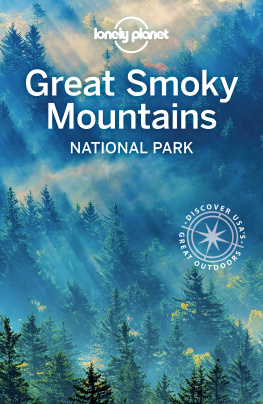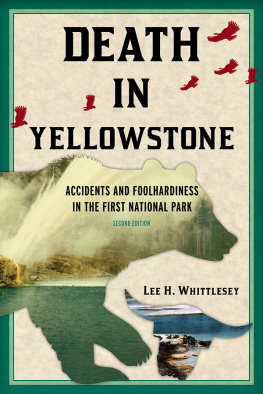DEATH IN THE GREAT SMOKY MOUNTAINS

An imprint of Rowman & Littlefield
Distributed by NATIONAL BOOK NETWORK
Copyright 2016 by Michael Bradley
All rights reserved. No part of this book may be reproduced in any form or by any electronic or mechanical means, including information storage and retrieval systems, without written permission from the publisher, except by a reviewer who may quote passages in a review.
British Library Cataloging in Publication Information Available
Library of Congress Cataloging-in-Publication Data is available on file.
ISBN 978-1-4930-2375-2
ISBN 978-1-4930-2563-3 (e-book)
 The paper used in this publication meets the minimum requirements of American National Standard for Information SciencesPermanence of Paper for Printed Library Materials, ANSI/NISO Z39.48-1992.
The paper used in this publication meets the minimum requirements of American National Standard for Information SciencesPermanence of Paper for Printed Library Materials, ANSI/NISO Z39.48-1992.
INTRODUCTION
THE GREAT SMOKY MOUNTAINS NATIONAL PARK STRADDLES the state lines of Tennessee and North Carolina and is within a days drive of about half the population of the United States. Not surprisingly, it is the most visited of all the national parks, with up to ten million people a year coming to enjoy the attractions of the area. Most of these visitors use only two roads: the Trans-Mountain Road between Cherokee, North Carolina, and Gatlinburg, Tennessee, and the Little River Road, which leads from the Sugarlands Visitors Center near Gatlinburg to Townsend with a branch leading to Cades Cove. Such crowds of people sometimes threaten to overwhelm the more popular roadside attractions, but visitors willing to leave their cars behind for a few minutes, or a few hours, can find the solitude of wilderness and wildness.
Covering more than eight hundred square miles with elevations ranging from about 875 feet above sea level to more than 6,643 feet, the park is very diverse in its climate. By driving from Gatlinburg on the Tennessee side of the park to Cherokee on the North Carolina side, one passes through as many climate zones as if one had driven from Tennessee to Quebec. The Canadian junco has no need to migrate from Tennessee or North Carolina to Canada for the summer; it simply needs to fly from the borders of the park to the mountain crest in the middle. Parts of the Tennessee and North Carolina zones are typical of the southern region of the United States, yet Newfound Gap and Clingmans Dome, along the high crest between the two often called State Line Ridge, are like Canada. With this great diversity of climate and habitat, the park is home to an astounding variety of flora and fauna. Over seventeen thousand species of plants and animals live in the park, and scientists estimate there may be from two to three times as many more as yet unidentified.
The Great Smokies also contains a unique collection of buildings that give a look into the Appalachian lifestyle of the nineteenth century, a way of life once followed all along the frontier of the United States. At Oconaluftee Visitors Center there is a collection of nineteenth-century buildings that have been moved from various locations, many of them from within the park, which recreates a typical mountain farm. At Cades Cove other buildings are scattered along the road that loops through the cove, with a focal point being Cables Mill, a working mill utilizing water power to grind corn into meal. Cabins can be found along Airport Road in Gatlinburg as it enters the park on its way to becoming the Roaring Fork Motor Nature Trail. Walking along park trails that once were roads, one may suddenly come upon cemeteries, reminders that people lived and died in the mountains long before the area became a park, as happens in the Cataloochee area.
There is no admission fee to enter the park. Congress authorized the creation of the park in 1926, but no money was appropriated for land acquisition or development. The states of Tennessee and North Carolina provided some money, and land was purchased from timber companies. The Rockefeller family donated five million dollars to assist the undertaking and schoolchildren participated in fund drives, giving pennies and nickels for the cause. It was not until 1934 that the park was considered to be established, and even then it took six more years to build the hiking trails and other facilities to welcome visitors. When President Franklin Roosevelt came to dedicate the park in September 1940, he reminded those assembled for the ceremonies that the legislation establishing the park had declared it to be a pleasuring ground free to the people. This was considered only proper when so many private citizens had helped to create the Great Smoky Mountains National Park.
The National Park Service (NPS), a division of the Department of the Interior, employs the people who care for the park and its visitors. These folks are usually called park rangers, and most visitors, on seeing these people wearing their distinctive green and gray uniforms with the distinctive Smokey Bear hats, do not realize what a wide variety of skills and tasks these rangers undertake. (By the way, Smokey Bear is properly associated with the US Forest Service, not the NPS.) Some of the NPS personnel you will meet in any park are seasonal rangers, employed for the busiest seasons in a particular park, and often moving from park to park in search of a succession of these seasonal jobs. Some of the rangers are law enforcement rangers, trained and authorized to act as law enforcement officers under the authority of the US government, since all national parks are federal property. This category of rangers is responsible for public safety and other issues concerning protection of the park and its visitors. Many rangers are involved in interpretation of the park, which includes leading guided walks, doing programs at campgrounds and visitor centers, manning the visitor centers, and generally representing the park to the public. Maintenance employees are not rangers but have the task of keeping the park clean and repairing or building facilities in the park. However, these Park Service employees may be the first to hear of an emergency in the park because they make the rounds of the campgrounds and picnic areas on a regular basis. There are some rangers park visitors probably will not meet. These are the administrators who work with the park budget, handle purchases for the park, and do many other necessary but out-of-sight jobs. Also generally out of sight are the resource management rangers, scientists and historians responsible for protecting the natural and historic resources of the park. All these people are ready and willing to help make a visit to the park a pleasant and safe experience. Some of them are called on to risk their lives in doing this; park rangers meet a wide variety of people who are visiting the park, and some of those people cause trouble or get into trouble. Park rangers share the same dangers as do special agents of the FBI, the Secret Service, and the agents of the Bureau of Alcohol, Tobacco, Firearms, and Explosives. A ranger may work in a beautiful place, but the job is demanding and sometimes dangerous.
Consider, with so much to offer, is it any wonder that the Great Smoky Mountains is the most visited of all the national parks? But even beauty can have a harsh side. Ten million visitors annually can, and do, create traffic problems that sometimes lead to accidents, even fatal ones. People who go hiking without proper equipment, especially without sturdy shoes, turn ankles or injure their feet.
On August 10, 2015, rangers responded to a call for help from Joey Watson, a twenty-year-old college student who was hiking the Miry Ridge Trail, which connects the Jakes Creek Trail with the Appalachian Trail. Park Service personnel trained as paramedics hiked for several hours to reach Joey and, on arriving, found he had broken his ankle. It was estimated it would take twelve hours to bring the injured hiker out of the park if he were carried, so the Tennessee Highway Patrolthe only state agency equipped to handle air evacuation rescueswas contacted to bring in their hoist-equipped U-1 Huey helicopter. This effort and expense was caused by Joey simply slipping and falling while walking on an established trail, the sort of accident that could have happened on a city sidewalk. Those who decide to leave the trails and go bushwhacking may find they have bitten off more than they can chew when the terrain becomes rougher and the foliage denser than they anticipated.










 The paper used in this publication meets the minimum requirements of American National Standard for Information SciencesPermanence of Paper for Printed Library Materials, ANSI/NISO Z39.48-1992.
The paper used in this publication meets the minimum requirements of American National Standard for Information SciencesPermanence of Paper for Printed Library Materials, ANSI/NISO Z39.48-1992.